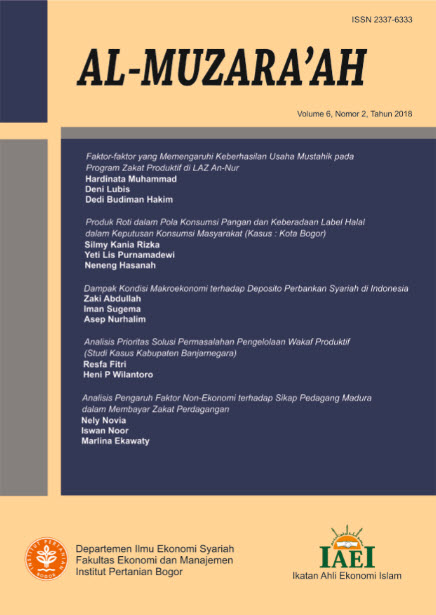Movements of Islamic Stock Indices in Selected OIC Countries
Main Article Content
Abstract
This study reviews the movement of Islamic stock indices in selected countries in the Organization of Islamic Cooperation (OIC) with high number of muslim population namely Indonesia, Malaysia, Turkey, Qatar, Bahrain, and Oman. The objectives are to examine the changes in cross market linkage among six selected OIC countries during crisis and after 2007 crisis and to analyze whether the international investor can gain benefit when allocating their funds across these markets. The set of relationship for each pair of Islamic stock index is analyzed using Engel-Granger (1987) and Autoregressive Distribution Lagged (ARDL) bound testing approach. The analysis is made for the sub period during crisis is 3 September 2007 – 11 January 2010 and post crisis is 18 January 2010 – 30 April 2013. The result depicts that there are evidences of cointegration among the Islamic stock markets after crisis but not during crisis. The long-run relationship indicates that investors can gain portfolio diversification benefit across these six countries.
Downloads
Article Details

This work is licensed under a Creative Commons Attribution-ShareAlike 4.0 International License.
Author(s) who published in this journal agree to following terms:
- Authors understand and agree that copyright of manuscripts published are held by Al-Muzara'ah. The statement to release the copyright to Al-Muzara'ah is stated in form CTA (link doc).
- Copyright encompass exclusive rights to reproduce, to distribute, and to sell any part of the journal articles in all form and media.
This work is licensed under a Creative Commons Attribution-ShareAlike 4.0 International License (CC BY-SA) where Authors and Readers can copy and redistribute the material in any medium or format, as well as remix, transform, and build upon the material for any purpose, but they must give appropriate credit (cite to the article or content), provide a link to the license, and indicate if changes were made. If you remix, transform, or build upon the material, you must distribute your contributions under the same license as the original.
References
Ceylan, Nildağ Başak and Doğan, Burak. (2004). Comovements of stock markets among selected OIC countries. Journal of Economic Cooperation, 3, 47–62.
Claessens, S., Lee, R., & Zechner, J. (2003). The future of stock exchanges in European Union Accession countries, Corporation of London, 1-35.
Darrat, A.F., Elkhal, K., & Hakim, S.R. (2000). On the Integration of emerging stock markets in the Middle East. Journal of Economic Development, 25(2), 119–129.
Ergun, U. & Hassan, S.M.N.A. (2009). Comovement and linkages of emerging stock markets : A case study from OIC member countries. Journal of Economic Cooperation and Development, 4(30), 105–119.
Hassan, M.K. & Yu, J.S. (2007). Stock exchange alliances in Organization of Islamic Cooperation (OIC). Working Paper. Network Financial Institute at Indiana State University, 2007-WP-18 July 2007.
Karim, B.A., Kassim, N.A.M., & Arip, M.A. (2010). The subprime crisis and Islamic stock markets integration. International Journal of Islamic and Middle Eastern Finance and Management, 3(4), 363–371.
Karim, B.A. & Karim, Z.A. (2012). Integration of ASEAN-5 stock markets: A revisit. Asian Academy of Management Journal of Accounting and Finance, 8(2), 21–41.
Kassim, S. (2013). The global financial crisis and the integration of Islamic stock markets in developed and developing countries. Asian Academy of Management Journal of Accounting and Finance, 9(2), 75–94.
Kenani, J.M., Purnomo, J., & Maoni, F. (2013). The Impact of the Global Financial Crisis on the Integration of the Chinese and Indonesian Stock Markets. International Journal of Economics and Finance, 5(9), 69–81.
Majid, M.S.A, Yusof, R.M., & Razali, A.N. (2007). Dynamic financial linkages among selected OIC countries. Journal of Economic Cooperation among Muslim Countries, 28(2), 25–56.
Majid, M.S.A & Kassim, S. (2010). Potential diversification benefits across Global Islamic Equity Markets. Journal of Economic Cooperation and Development, 4(31), 103–126.
Marashdeh, H. (2005). Stock market integration in the MENA region : An application of the ARDL bounds testing approach. Working Paper. Faculty of Business. University of Wollongong.
Trabelsi, M.A., (2011). The impact of the financial crisis on the global economy: Can the Islamic financial system help?. The Journal of Risk Finance, 12(1), 15-25.
Nor, M.I. (2012). Financial Market integration of Middle East and North African (MENA) countries. Asian Journal of Management Sciences and Education, 1(2), 63–72.
Hussin, M.Y.M., Yusof, YA., Muhammad, F., Razak, A.A., Hashim, E., & Marwan, N.F. (2013). The integration of Islamic stock. Labuan e-Journal of Muamalat and Society, 7, 17–27.
Narayan, P.K. (2004). Reformulating critical values for the bounds f-statistics approach to cointegration: An application to the tourism demand model for Fiji (Discussion Paper No. 02/04). Australia: Department of Economics, Monash University.
Neaime, S. (2005). Financial Market Integration and Macroeconomic Volatility in the MENA Region: An Empirical Investigation. Beirut.
Paskelin, O., Nguyen, C.V., & Jones, K. (2013). Did financial market integration really happen in MENA region? An analysis. J. Econ. Coop. Dev, 34(1), 111-134.
Pesaran, M.H., Shin, Y. (1995). An autoregressive distributed lag modelling approach to cointegration analysis. Paper presented at the Symposium for Cetennial of Ragnar Frisch, Oslo, March 3-5, 1995.
Pesaran, M.H., Shin, Y., & Smith, R.J. (2001). Bounds testing approaches to the analysis of level relationships. Journal of Applied Econometrics, 16, 289–326.
SESRIC. (2012). Islamic Finance in OIC Member Countries: OIC Outlook Series (p. 18).

